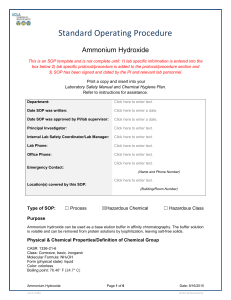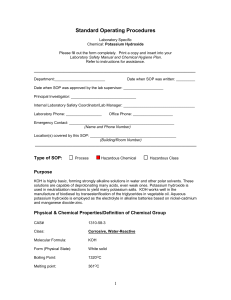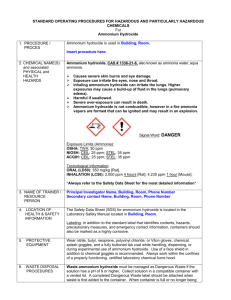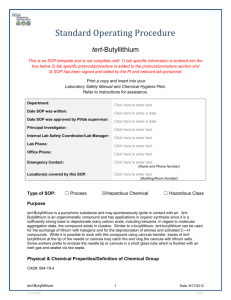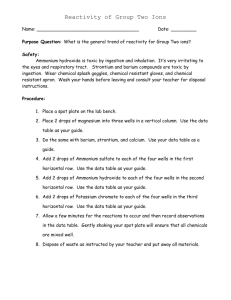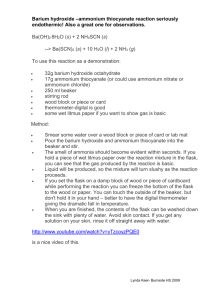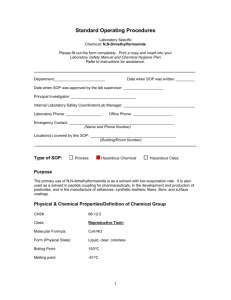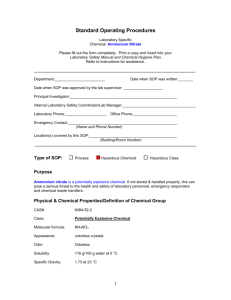Ammonium Hydroxide
advertisement
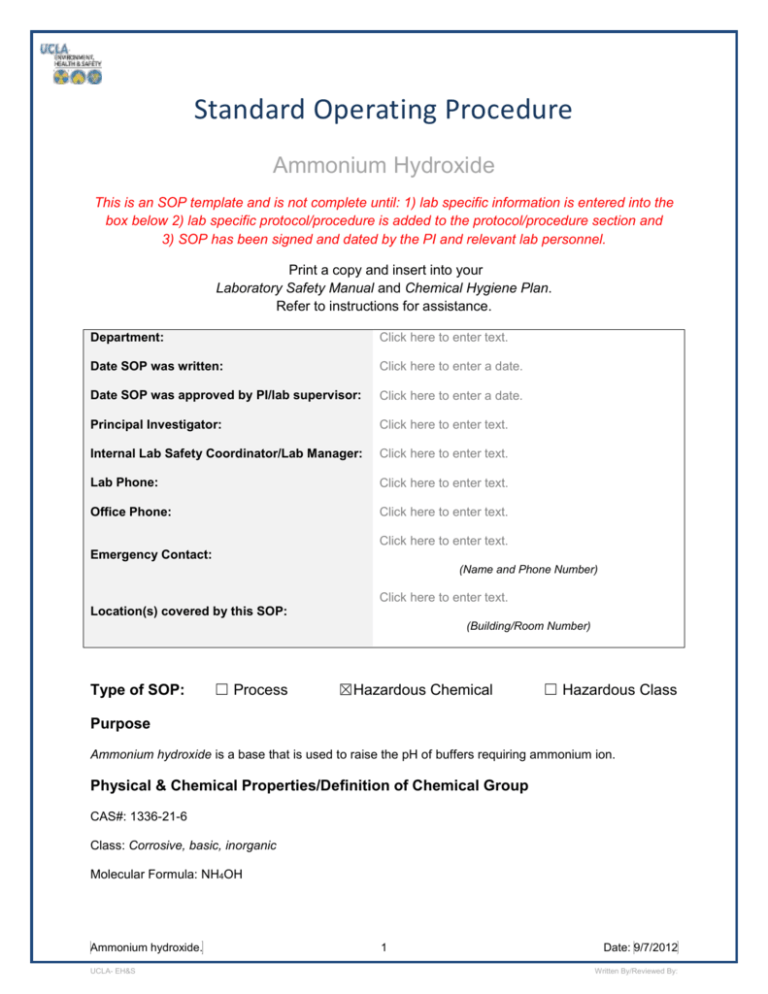
Standard Operating Procedure Ammonium Hydroxide This is an SOP template and is not complete until: 1) lab specific information is entered into the box below 2) lab specific protocol/procedure is added to the protocol/procedure section and 3) SOP has been signed and dated by the PI and relevant lab personnel. Print a copy and insert into your Laboratory Safety Manual and Chemical Hygiene Plan. Refer to instructions for assistance. Department: Click here to enter text. Date SOP was written: Click here to enter a date. Date SOP was approved by PI/lab supervisor: Click here to enter a date. Principal Investigator: Click here to enter text. Internal Lab Safety Coordinator/Lab Manager: Click here to enter text. Lab Phone: Click here to enter text. Office Phone: Click here to enter text. Click here to enter text. Emergency Contact: (Name and Phone Number) Click here to enter text. Location(s) covered by this SOP: (Building/Room Number) Type of SOP: ☐ Process ☒Hazardous Chemical ☐ Hazardous Class Purpose Ammonium hydroxide is a base that is used to raise the pH of buffers requiring ammonium ion. Physical & Chemical Properties/Definition of Chemical Group CAS#: 1336-21-6 Class: Corrosive, basic, inorganic Molecular Formula: NH4OH Ammonium hydroxide. UCLA- EH&S 1 Date: 9/7/2012 Written By/Reviewed By: Form (physical state): liquid Color: colorless Boiling point: 76.46° F (24.7° C) Potential Hazards/Toxicity Poison! Danger! Corrosive. May be fatal if swallowed or inhaled. Mist and vapor cause burns to every area of contact. Causes severe burns to skin, eyes, respiratory tract and gastrointestinal tract. Personal Protective Equipment (PPE) Respirator Protection None required. Respirators should be used only under any of the following circumstances: As a last line of defense (i.e., after engineering and administrative controls have been exhausted). When Permissible Exposure Limit (PEL) has exceeded or when there is a possibility that PEL will be exceeded. Regulations require the use of a respirator. An employer requires the use of a respirator. There is potential for harmful exposure due to an atmospheric contaminant (in the absence of PEL) As PPE in the event of a chemical spill clean-up process Lab personnel intending to use/wear a respirator mask must be trained and fit-tested by EH&S. This is a regulatory requirement. (http://map.ais.ucla.edu/go/1004655) Hand Protection Nitrile gloves are recommended. NOTE: Consult with your preferred glove manufacturer to ensure that the gloves you plan on using are compatible with ammonium hydroxide. Refer to glove selection chart from the links below: http://www.ansellpro.com/download/Ansell_8thEditionChemicalResistanceGuide.pdf OR http://www.allsafetyproducts.biz/page/74172 OR http://www.showabestglove.com/site/default.aspx OR http://www.mapaglove.com/ Eye Protection ANSI approved goggles are required. Skin and Body Protection Lab coat, long pants, and closed-toe shoes are required. Ammonium hydroxide. UCLA- EH&S 2 Date: 9/7/2012 Written By/Reviewed By: Hygiene Measures After working with ammonium hydroxide, immediately remove gloves, wash hands and arms with soap and water. Engineering Controls Work with ammonium hydroxide in a certified ducted fume hood. First Aid Procedures If inhaled Remove to fresh air. If not breathing, give artificial respiration. If breathing is difficult, give oxygen. Call a physician In case of skin contact Immediately flush skin with plenty of soap and water for at least 15 minutes while removing contaminated clothing and shoes. Get medical attention immediately In case of eye contact Immediately flush eyes with copious amounts of water for at least 15 minutes while removing contaminated clothing and shoes. Get medical attention immediately If swallowed Wash out mouth with water provided person is conscious. Never give anything by mouth to an unconscious person. Call a physician. Special Handling and Storage Requirements Keep in tightly closed container. Store in a cool, dry corrosion-proof, ventilated area away from moisture, sources of heat or ignition, combustibles and oxidizers. Protect against physical damage. Always add the caustic to water while stirring, never the reverse. Containers of these materials may be hazardous when empty since they may retain product residues (dust, solids), observe all warnings and precautions. Incompatibilities with ammonium hydroxide: acids, acrolein dimethyl sulfate, halogens, silver nitrate, propylene oxide, nitromethane, silver oxide, silver permanganate, oleum, beta-propiolactone. Most common metals. Spill and Accident Procedure Chemical Spill Dial 911 and x59797 Spill – Assess the extent of danger. Help contaminated or injured persons. Evacuate the spill area. Avoid breathing vapors. If possible, confine the spill to a small area using a spill kit or absorbent material. Keep others from entering contaminated area (e.g., use caution tape, barriers, etc.). Small (<1 L) – If you have training, you may assist in the clean-up effort. Use appropriate personal protective equipment and clean-up material for chemical spilled. Double bag spill waste in clear plastic bags, label and take to the next chemical waste pick-up. Large (>1 L) – Dial 911 (or 310-825-1491 from cell phone) and EH&S at x59797 for assistance. Ammonium hydroxide. UCLA- EH&S 3 Date: 9/7/2012 Written By/Reviewed By: Chemical Spill on Body or Clothes – Remove clothing and rinse body thoroughly in emergency shower for at least 15 minutes. Seek medical attention. Notify supervisor and EH&S at x59797 immediately. Chemical Splash Into Eyes – Immediately rinse eyeball and inner surface of eyelid with water from the emergency eyewash station for 15 minutes by forcibly holding the eye open. Seek medical attention. Notify supervisor and EH&S at x59797 immediately. Medical Emergency Dial 911 or x52111 Life Threatening Emergency, After Hours, Weekends And Holidays – Dial 911 (or 310-825-1491 from cell phone) or contact the Ronald Reagan UCLA Medical Center (emergency room) directly at x52111 (located at 757 Westwood Plaza, enter from Gayley Avenue). Note: All serious injuries must be reported to EH&S at x59797 within 8 hours. Non-Life Threatening Emergency – Go to the Occupational Health Facility (OHF), x56771, CHS room 67-120 (This is on the 6th floor, 7th corridor, room 120. Enter through the School of Dentistry on Tiverton Drive and proceed to the “O” elevator to the 6th floor.)Hours: M - F, 7:30 a.m. to 4:30 p.m. At all other times report to Ronald Regan UCLA Medical Center (emergency room) at x52111. Note: All serious injuries must be reported to EH&S at x59797 within 8 hours. Needle stick/puncture exposure (as applicable to chemical handling procedure) – Wash the affected area with antiseptic soap and warm water for 15 minutes. For mucous membrane exposure, flush the affected area for 15 minutes using an eyewash station. Page the needle stick nurse by dialing 231 from a campus phone, enter 93333 when prompted and then enter your extension. Hours: M – F, 8:00 a.m. to 4:00 p.m. At all other times report to Ronald Regan UCLA Medical Center (emergency room) at x52111. Note: All needle stick/puncture exposures must be reported to EH&S at x59797 within 8 hours. Decontamination/Waste Disposal Procedure Lab coats must be decontaminated before they are removed for laundering. This may be accomplished by washing the affected area in small container of soap and water. Dispose of the soap and water as hazardous waste. Laboratory work surfaces and equipment shall be decontaminated at the conclusion of each procedure and at the end of each day. Use a soapy, wet paper towel to clean the affected areas and dispose of the paper towel as hazardous waste. General hazardous waste disposal guidelines: Label Waste Affix an on-line hazardous waste tag on all waste containers using the Online Tag Program http://otp.ucop.edu/ as soon as the first drop of waste is added to the container Store Waste Store hazardous waste in closed containers, in secondary containment and in a designated location Double-bag dry waste using transparent bags http://map.ais.ucla.edu/go/1002774 Waste must be under the control of the person generating & disposing of it Dispose of Waste Dispose of regularly generated chemical waste within 90 days Call EH&S at x61887 for questions Empty Containers Ammonium hydroxide. UCLA- EH&S 4 Date: 9/7/2012 Written By/Reviewed By: o Dispose as hazardous waste if it once held extremely hazardous waste (irrespective of the container size) http://ehs.ucla.edu/Pub/ExtremelyHazardousWaste.pdf o Consult waste pick-up schedule http://ehs.ucla.edu/pub/HazWaste%20Pickup%20Schedule.pdf Prepare for transport to pick-up location Check on-line waste tag Write date of pick-up on the waste tag Use secondary containment Safety Data Sheet (SDS) Location Online SDS can be accessed at http://msds.ehs.ucla.edu. Protocol/Procedure Use a transfer pipette to add small amounts of ammonium hydroxide (less than 1 ml at a time) to a buffer requiring an increase in pH by ammonium hydroxide. Transfer in the fume hood and then test the pH of the solution. As the pH gets closer to desired point, dilute the ammonium hydroxide 10-fold in water by transferring one ml to 9 ml of ddH20. Transfer this diluted form to the buffer until desired pH is reached. NOTE Any deviation from this SOP requires approval from PI. Documentation of Training (signature of all users is required) Prior to conducting any work with Click here to enter chemical name or class., designated personnel must provide training to his/her laboratory personnel specific to the hazards involved in working with this substance, work area decontamination, and emergency procedures. The Principal Investigator must provide his/her laboratory personnel with a copy of this SOP and a copy of the SDS provided by the manufacturer. The Principal Investigator must ensure that his/her laboratory personnel have attended appropriate laboratory safety training or refresher training within the last one year. I have read and understand the content of this SOP: Name Signature Date Click here to enter text. Click here to enter a date. Click here to enter text. Click here to enter a date. Click here to enter text. Click here to enter a date. Ammonium hydroxide. UCLA- EH&S 5 Date: 9/7/2012 Written By/Reviewed By: Click here to enter text. Click here to enter a date. Click here to enter text. Click here to enter a date. Click here to enter text. Click here to enter a date. Click here to enter text. Click here to enter a date. Click here to enter text. Click here to enter a date. Click here to enter text. Click here to enter a date. Click here to enter text. Click here to enter a date. Click here to enter text. Click here to enter a date. Click here to enter text. Click here to enter a date. Click here to enter text. Click here to enter a date. Click here to enter text. Click here to enter a date. Click here to enter text. Click here to enter a date. Ammonium hydroxide. UCLA- EH&S 6 Date: 9/7/2012 Written By/Reviewed By:
